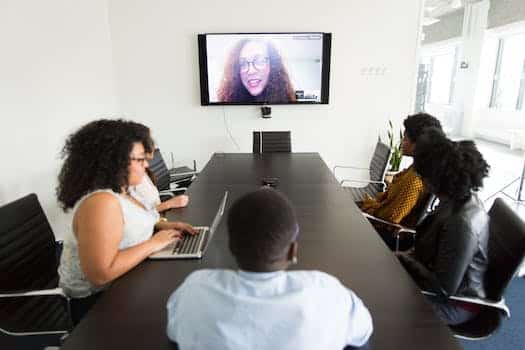Collaboration is a crucial aspect of remote work that offers numerous benefits to both individuals and organizations. In today’s digital age, remote collaboration has become increasingly prevalent, allowing teams to work together seamlessly across different geographical locations. This article explores the advantages of collaboration in remote work, highlighting how it enhances productivity, fosters creativity, encourages diverse perspectives, and promotes a sense of camaraderie among team members. By leveraging technology and effective communication strategies, remote collaboration enables businesses to thrive in a globalized and interconnected world.
- 1. Introduction
- 1.1. What is collaboration remote work?
- 1.2. Importance of collaboration in remote work
- 1.3. Benefits of remote collaboration
- 1.4. Challenges of remote collaboration
- 1.5. Tools and technologies for remote collaboration
- 2. Best Practices for Collaborative Remote Work
- 2.1. Establishing clear communication channels
- 2.2. Setting goals and expectations
- 2.3. Using project management tools
- 2.4. Regular check-ins and updates
- 2.5. Promoting a collaborative culture
- 3. Building Trust and Engagement in Remote Collaboration
1. Introduction
In today’s digital age, remote work has become increasingly popular among individuals and companies alike. With the advancements in technology and communication tools, collaborating with colleagues from different locations has never been easier. Collaboration in remote work refers to the act of working together on projects, tasks, or ideas without being physically present in the same office space. This article will explore the numerous benefits of collaboration in remote work and how it can positively impact individuals and organizations.
1.1. What is collaboration remote work?
Collaboration remote work refers to the practice of individuals working together on a project or task, despite being geographically separated. With advancements in technology and the rise of remote work, collaboration no longer requires physical proximity. Instead, teams can collaborate effectively through various online tools and platforms.
Remote collaboration allows individuals from different locations, time zones, and even countries to come together and work towards a common goal. It involves sharing ideas, exchanging feedback, and collectively making decisions. This type of work setup promotes flexibility, as team members can work from anywhere while still contributing their expertise.
Collaboration in remote work relies heavily on effective communication and the utilization of digital tools. By leveraging video conferencing, project management software, chat platforms, and document sharing systems, teams can interact in real-time and stay connected. This enables seamless collaboration, ensuring that everyone is on the same page and working towards the project’s success.
In summary, collaboration remote work is a modern approach that allows individuals to work together, regardless of their physical location. It offers flexibility, promotes effective communication, and harnesses the power of technology to achieve shared goals.
1.2. Importance of collaboration in remote work
Collaboration plays a crucial role in remote work, bringing numerous benefits to both individuals and organizations. As more and more companies embrace remote work, it becomes increasingly important to understand the significance of collaboration in this context. Remote work, by its nature, requires individuals to work independently and often in isolation, which can lead to feelings of disconnection and reduced productivity. However, when collaboration is fostered effectively, it can mitigate these challenges and create a sense of unity and shared purpose among remote teams. This article will explore the importance of collaboration in remote work and highlight the advantages it brings.
1.3. Benefits of remote collaboration
Remote collaboration offers numerous benefits for individuals and organizations alike. In today’s digital age, where remote work is becoming increasingly common, collaboration tools and technologies have revolutionized the way teams work together. This article will explore the advantages of remote collaboration and how it can enhance productivity, foster creativity, and improve communication in a remote work environment.
1.4. Challenges of remote collaboration
Remote collaboration has become increasingly prevalent in today’s work environment. While it offers numerous benefits, it also presents several challenges that need to be addressed. This article will explore some of the common obstacles faced by individuals and teams engaging in remote collaboration.
One of the primary challenges is the lack of face-to-face interaction. In traditional office settings, team members can easily communicate and collaborate in person, which fosters a sense of camaraderie and enhances productivity. However, in remote work, communication mainly relies on virtual platforms, making it harder to build personal connections and establish trust.
Another challenge is the potential for miscommunication. Non-verbal cues, such as body language and facial expressions, play a crucial role in understanding and interpreting messages. In remote collaboration, these cues are often lost or misinterpreted through digital communication channels, leading to misunderstandings and conflicts.
Time zone differences also pose a challenge to remote collaboration. When team members are located in different parts of the world, coordinating meetings and ensuring everyone’s availability can be a logistical nightmare. Scheduling conflicts and delays in response times can hinder productivity and hinder effective collaboration.
Lastly, the lack of immediate access to resources and information can impede remote collaboration. In a physical office, colleagues can easily share documents, access shared drives, and seek assistance from each other. However, in remote work, accessing and sharing information may require additional steps, causing delays and hindering seamless collaboration.
Despite these challenges, remote collaboration can still be highly rewarding and productive. The key lies in recognizing and addressing these obstacles to create an environment conducive to effective remote collaboration.
1.5. Tools and technologies for remote collaboration
Remote collaboration has become increasingly popular in today’s digital age. With advancements in technology, organizations are now able to connect and work together seamlessly, regardless of physical location. This shift in work dynamics has brought about numerous benefits for both companies and employees. In this article, we will explore the various tools and technologies that facilitate remote collaboration and discuss how they enhance productivity and teamwork.
2. Best Practices for Collaborative Remote Work
Collaborative remote work has become increasingly popular in recent years. As more companies embrace remote work policies, it is essential to establish best practices for effective collaboration. Here are some key strategies for successful collaborative remote work:
1. Communication: Clear and consistent communication is the cornerstone of collaboration in remote work. Utilize various communication tools such as video conferencing, instant messaging, and project management software to ensure team members stay connected and informed.
2. Establish Goals and Expectations: Clearly define project goals and expectations from the beginning. This will help remote team members understand their roles and responsibilities, ensuring everyone is on the same page.
3. Foster Trust and Accountability: Trust is crucial in remote work environments. Encourage team members to take ownership of their tasks and deliverables. Regular check-ins and progress updates can help maintain accountability.
4. Leverage Technology: Take advantage of technology to facilitate collaboration. Use online collaboration tools, file-sharing platforms, and project management software to streamline workflows and improve efficiency.
5. Promote Team Bonding: Remote work doesn’t mean isolating team members. Encourage virtual team-building activities, such as virtual coffee breaks or online team games, to foster a sense of camaraderie and connection.
6. Set Clear Deadlines: Establishing clear deadlines for tasks and projects is essential for keeping remote teams on track. This helps team members prioritize their work and ensures timely completion.
7. Encourage Collaboration and Idea Sharing: Actively promote collaboration among remote team members. Encourage idea sharing, brainstorming sessions, and cross-functional collaboration to leverage diverse perspectives and expertise.
By implementing these best practices, companies can maximize the benefits of collaboration in remote work. Effective collaboration leads to increased productivity, innovation, and overall team success.
2.1. Establishing clear communication channels
In order to ensure effective collaboration in remote work, it is crucial to establish clear communication channels. By implementing best practices for communication, teams can overcome the challenges of distance and work together seamlessly.
One of the first steps in establishing clear communication channels is to determine the most suitable platforms for collaboration. This may include video conferencing tools, instant messaging applications, project management software, or a combination of various platforms. It is important to choose platforms that are user-friendly, reliable, and accessible to all team members.
Another best practice is to establish and communicate clear guidelines for communication. This includes setting expectations for response times, preferred communication methods, and the use of appropriate language and tone. By establishing these guidelines, team members can avoid misunderstandings and ensure that everyone is on the same page.
Regular check-ins and updates are also essential for effective remote collaboration. Scheduling regular video or audio calls, team meetings, or status updates can help keep everyone informed about the progress of projects, address any challenges, and maintain a sense of connection among team members.
Additionally, utilizing collaborative tools and technologies can greatly enhance remote work collaboration. Cloud-based document sharing and editing platforms, project management software with task assignment and tracking features, and virtual whiteboards for brainstorming sessions are just a few examples of tools that can facilitate collaboration and productivity.
Finally, fostering a culture of open communication and feedback is vital in remote work environments. Encouraging team members to share ideas, ask questions, and provide constructive feedback helps to build trust, improve collaboration, and drive innovation.
By following these best practices and establishing clear communication channels, remote teams can maximize the benefits of collaboration and thrive in their work environment.
2.2. Setting goals and expectations
Setting goals and expectations is crucial for successful collaborative remote work. When working remotely, it is important to have a clear understanding of what needs to be achieved and the expectations for each team member.
To set effective goals, it is essential to establish clear objectives that are specific, measurable, attainable, relevant, and time-bound (SMART). This ensures that everyone is on the same page and working towards a common purpose.
Additionally, it is important to communicate and discuss expectations openly with the team. This includes setting expectations for communication channels, response times, availability, and deliverables. By clearly defining expectations, team members can work together more efficiently and effectively.
Regularly reviewing and revisiting goals and expectations is also important. As circumstances change and projects progress, it is necessary to adapt and update goals accordingly. This allows for continuous improvement and ensures that the team remains aligned and focused on achieving the desired outcomes.
In summary, setting goals and expectations is a fundamental aspect of collaborative remote work. It provides clarity, direction, and accountability for all team members, ultimately leading to successful collaboration and accomplishment of shared objectives.
2.3. Using project management tools
Using project management tools is essential for ensuring effective collaboration in remote work environments. These tools help teams stay organized, communicate efficiently, and track progress on various tasks and projects. Here are some best practices for utilizing project management tools for collaborative remote work:
1. Choose the right tool: Select a project management tool that aligns with your team’s needs and preferences. There are numerous options available, such as Trello, Asana, and Monday.com. Consider factors like ease of use, features offered, and compatibility with other tools your team utilizes.
2. Set clear goals and expectations: Clearly define the project’s objectives, deliverables, and timelines. Use the project management tool to document and communicate these goals to ensure everyone is on the same page.
3. Assign and delegate tasks: Use the tool’s task assignment feature to assign specific responsibilities to team members. Clearly communicate expectations and deadlines for each task to avoid confusion or delays.
4. Foster communication and collaboration: Project management tools offer various communication channels like chat, comments, and notifications. Encourage team members to use these features to share updates, ask questions, and provide feedback. This facilitates real-time collaboration and ensures everyone stays informed.
5. Track and monitor progress: Utilize the project management tool’s tracking and reporting features to monitor the progress of tasks and projects. Regularly review and update task statuses, milestones, and deadlines to ensure everything is on track.
6. Encourage transparency and visibility: Make sure all relevant project information, files, and documents are easily accessible to team members through the project management tool. This promotes transparency, eliminates silos, and helps team members stay informed about project developments.
7. Regularly evaluate and optimize: Continuously assess the effectiveness of your project management tool and processes. Seek feedback from team members and make necessary adjustments to improve collaboration and productivity.
By following these best practices and leveraging project management tools, remote teams can enhance collaboration, streamline workflows, and achieve successful project outcomes.
2.4. Regular check-ins and updates
Regular check-ins and updates are essential for effective collaboration in remote work. When team members are physically separated, it is crucial to establish a routine of frequent communication to ensure everyone remains aligned and connected.
These regular check-ins can take various forms, such as team meetings, conference calls, or video conferences. The frequency and format of these check-ins can be determined based on the nature of the project and the preferences of the team.
During these check-ins, team members can share progress updates, discuss challenges, and provide support to one another. It allows everyone to stay informed about the overall progress of the project and identify any potential roadblocks or issues that need to be addressed.
In addition to regular check-ins, updates should also be shared on collaborative platforms or tools that facilitate real-time collaboration. This ensures that everyone has access to the most up-to-date information and can contribute to the project effectively.
By implementing regular check-ins and updates, remote teams can foster a sense of accountability, transparency, and collaboration. It helps to maintain productivity, ensures everyone is on the same page, and promotes a positive work culture even in a remote setting.
2.5. Promoting a collaborative culture
Promoting a collaborative culture is essential for successful remote work. When team members are spread across different locations, it becomes crucial to establish effective communication and collaboration practices. Here are some best practices for promoting collaboration in remote work:
1. Clear Communication Channels: Use tools like email, instant messaging, and video conferencing to ensure smooth and frequent communication among team members. Encourage everyone to be responsive and proactive in their communication.
2. Shared Project Management Tools: Utilize project management software that allows team members to collaborate on tasks, share documents, and track progress. This ensures transparency and accountability within the team.
3. Establish Regular Check-ins: Schedule regular virtual meetings or check-ins to discuss project updates, address any challenges, and foster a sense of unity among team members. This helps in maintaining a strong connection and keeps everyone aligned.
4. Encourage Knowledge Sharing: Create a culture of knowledge sharing by organizing virtual workshops or webinars where team members can share their expertise and learn from each other. This promotes collaboration and continuous learning.
5. Foster a Positive Team Environment: Encourage team members to support and motivate each other. Recognize and appreciate individual and collective achievements to boost morale and create a positive remote work culture.
By implementing these best practices, organizations can create a collaborative remote work environment that enhances productivity, innovation, and employee satisfaction.
3. Building Trust and Engagement in Remote Collaboration
Remote collaboration offers numerous benefits for individuals and organizations alike. However, building trust and engagement in remote collaboration can be a challenge. When working remotely, team members may feel isolated and disconnected from their colleagues, which can hinder effective collaboration. Here are some strategies to foster trust and engagement in remote collaboration:
1. Clear Communication: Effective communication is crucial in remote collaboration. Team members should regularly communicate their expectations, progress, and challenges. Utilizing various communication tools such as video conferences, instant messaging, and project management software can help keep everyone on the same page.
2. Establishing Common Goals: It is essential to establish common goals and objectives for the team. When team members understand the bigger picture and how their individual contributions align with the overall objectives, it creates a sense of purpose and fosters engagement.
3. Encourage Collaboration and Cooperation: Remote collaboration should encourage team members to collaborate and cooperate with one another. This can be done through virtual team-building activities, brainstorming sessions, and regular check-ins to ensure everyone is working together towards a common goal.
4. Building Relationships: Trust is built through relationships. Even in a remote setting, it is important to create opportunities for team members to connect on a personal level. This can be done through virtual coffee breaks, team-building exercises, or informal video chats. Creating a sense of camaraderie and friendship helps foster trust and engagement.
5. Recognize and Appreciate Contributions: Remote collaboration can sometimes make it challenging to recognize and appreciate individual contributions. However, it is crucial to acknowledge and celebrate achievements. This can be done through public recognition, virtual team celebrations, or simply expressing gratitude for a job well done.
By implementing these strategies, organizations can build trust and engagement in remote collaboration, leading to increased productivity, creativity, and overall satisfaction among team members.
3.1. Fostering open and transparent communication
Open and transparent communication plays a crucial role in fostering trust and engagement in remote collaboration. When team members are physically separated, it becomes even more important to establish effective communication channels to ensure everyone is on the same page.
In remote work settings, the absence of face-to-face interactions and non-verbal cues can create misunderstandings and misinterpretations. By promoting open and transparent communication, organizations can mitigate these challenges and build a stronger collaborative environment.
One key aspect of fostering open communication is encouraging active participation from all team members. This can be achieved through regular virtual meetings, video conferences, and online collaboration tools. By providing a platform for individuals to voice their opinions, ask questions, and share ideas, organizations can create an inclusive culture where everyone feels valued.
Transparency is another crucial element in remote collaboration. It involves sharing information, progress updates, and decisions with the entire team. When team members have access to relevant information, they can make informed decisions and contribute effectively to the overall goals of the project.
Building trust in remote collaboration requires consistent and clear communication. Team members should be encouraged to provide feedback, express concerns, and offer suggestions freely. When individuals feel comfortable and supported in sharing their thoughts, trust is fostered, leading to increased engagement and productivity.
In conclusion, fostering open and transparent communication is essential for building trust and engagement in remote collaboration. By promoting active participation, transparency, and providing a platform for effective communication, organizations can create a collaborative environment where team members feel empowered and connected.
3.2. Encouraging active participation
Encouraging active participation is crucial for building trust and engagement in remote collaboration. When team members actively participate, they feel valued and involved, which leads to stronger relationships and more productive outcomes. Here are some strategies to foster active participation in remote collaboration:
1. Set clear expectations: Clearly communicate the goals, roles, and responsibilities of each team member. This helps everyone understand their contribution and encourages them to actively engage in the collaboration process.
2. Promote open communication: Encourage team members to share their ideas, concerns, and feedback openly. Create a safe and inclusive environment where everyone feels comfortable expressing their thoughts without fear of judgment.
3. Utilize collaborative tools: Leverage technology and collaborative tools to facilitate active participation. Use video conferencing, project management platforms, and instant messaging tools to encourage real-time communication and collaboration.
4. Provide regular feedback and recognition: Regularly acknowledge and appreciate the contributions of team members. This boosts morale and motivates them to continue actively participating in the collaboration.
5. Foster a sense of belonging: Create opportunities for team bonding and informal interactions. Virtual team-building activities, such as virtual coffee breaks or online games, can help foster a sense of belonging and strengthen engagement.
By implementing these strategies, remote teams can build trust, enhance engagement, and reap the numerous benefits of collaboration in remote work environments.
3.3. Recognizing and celebrating achievements
Recognizing and celebrating achievements in remote collaboration is crucial for building trust and engagement among team members. In a remote work setting, where physical interactions are limited, it is important to find alternative ways to acknowledge the accomplishments of individuals and the team as a whole.
One effective method is to establish a system of regular feedback and recognition. This can be done through virtual meetings, email communications, or even dedicated chat channels. By openly acknowledging and celebrating achievements, team members feel valued and motivated to continue their efforts.
Another way to build trust and engagement is by fostering a positive and inclusive work environment. Encouraging open communication, active participation, and mutual respect among team members creates a sense of belonging and promotes collaboration. This can be achieved through team-building activities, virtual social events, or even informal check-ins to ensure everyone feels connected and supported.
Furthermore, it is important to provide opportunities for personal and professional growth within the remote work setup. Offering training programs, skill development initiatives, or mentorship opportunities not only enhance individual capabilities but also demonstrate a commitment to the success and well-being of team members. Recognizing and supporting their aspirations and goals builds trust and encourages active engagement in remote collaboration.
In conclusion, recognizing and celebrating achievements, fostering a positive work environment, and providing growth opportunities are essential for building trust and engagement in remote collaboration. By implementing these strategies, teams can overcome the challenges of remote work and create a productive and cohesive virtual environment.
3.4. Promoting virtual team-building activities
Building trust and engagement in remote collaboration is crucial for successful virtual team-building activities. In a remote work setting, where team members may be physically distant from each other, it is important to establish a strong sense of trust and connection to enhance collaboration and productivity. Here are some effective strategies to promote trust and engagement in remote teams:
1. Communication is key: Foster open and transparent communication channels to encourage team members to share ideas, concerns, and feedback. Utilize various communication tools such as video conferencing, instant messaging, and project management platforms to facilitate seamless communication.
2. Establish clear expectations: Clearly define roles, responsibilities, and project objectives for each team member. This helps to align everyone’s understanding of their contribution and promotes accountability.
3. Encourage virtual social interactions: Organize virtual team-building activities, such as virtual coffee breaks or online games, to foster social connections among team members. This helps to build camaraderie and trust.
4. Provide regular feedback and recognition: Remote team members often miss out on immediate feedback and recognition. Establish a feedback culture by providing timely and constructive feedback. Recognize and appreciate team members’ efforts and achievements to boost morale and engagement.
5. Foster a positive work culture: Create a supportive and inclusive work environment where team members feel valued and respected. Encourage collaboration, knowledge sharing, and mutual support among team members.
By implementing these strategies, organizations can promote trust and engagement in remote collaboration, leading to improved teamwork, productivity, and overall success in virtual team-building activities.
3.5. Providing opportunities for professional growth
Building Trust and Engagement in Remote Collaboration
Remote work has become increasingly common in today’s digital age, and with it comes the need for effective collaboration. While there are many benefits to remote work, such as flexibility and increased productivity, building trust and engagement among team members can be a challenge. However, by implementing certain strategies, professionals can create opportunities for professional growth and foster a sense of trust and engagement in remote collaboration.
One key strategy is to establish clear communication channels. In remote collaboration, it is crucial to have open and transparent lines of communication to ensure that everyone is on the same page. This can be achieved through the use of various digital tools such as instant messaging platforms, video conferencing software, and project management systems. By providing team members with the means to easily communicate and share ideas, trust and engagement can be nurtured.
Another important aspect is promoting inclusivity and diversity within remote teams. By embracing diversity and creating an inclusive environment, professionals can tap into a wider range of perspectives and ideas. This not only enhances creativity and innovation but also fosters a sense of belonging and trust among team members. Encouraging open dialogue and valuing different opinions can lead to stronger collaboration and ultimately, professional growth.
Additionally, providing opportunities for skill development and growth is essential. Remote professionals should be encouraged to continually enhance their skills and expand their knowledge base. This can be done through various means such as offering online training courses, providing mentorship programs, or organizing virtual workshops and conferences. By investing in the professional growth of remote team members, organizations can strengthen trust and engagement, as individuals feel valued and supported in their career progression.
In conclusion, building trust and engagement in remote collaboration is crucial for reaping the benefits of collaboration in remote work. Clear communication channels, promotion of inclusivity and diversity, and providing opportunities for professional growth are key strategies to foster trust and engagement among remote team members. By implementing these strategies, professionals can create a productive and thriving remote work environment.
Conclusion
In conclusion, the benefits of collaboration in remote work are numerous. It allows for increased flexibility, improved productivity, enhanced creativity, and better work-life balance. Remote collaboration also promotes diversity, fosters a sense of teamwork, and enables companies to tap into a global talent pool. Overall, embracing collaboration in remote work can lead to significant growth and success for organizations in today’s digital age.






5 Comments
Walliw Korney
9 months agoTeamwork plays a pivotal role in remote work settings, offering significant advantages that ultimately lead to amplified productivity and enhanced creativity. Collaborating remotely fosters a synergistic environment where individuals with diverse skillsets and perspectives can come together to tackle complex challenges. By pooling together their expertise, team members can brainstorm innovative solutions, leveraging each others strengths to achieve improved outcomes. Moreover, remote teamwork enables efficient division of labor, allowing team members to simultaneously work on different aspects of a project, thereby reducing overall turnaround time. This cohesive approach not only boosts productivity but also promotes a sense of camaraderie and mutual support among team members, ensuring a harmonious working relationship. Consequently, the cumulative effect of enhanced productivity and increased creativity in remote work settings underscores the inherent advantages of effective teamwork.
Nessi Pegasus
9 months agoTeamwork in remote work settings can be a game-changer, folks! 🙌🏼 Working together, even when were physically apart, can take productivity and creativity to a whole new level. 🚀 So, lets embrace the power of collaboration and make those virtual workspaces shine! 💪🏼✨
Kalindi Boucher
9 months agoWow, this post really highlights the benefits of teamwork in remote work settings! Its amazing how collaborating with others can boost productivity and foster creativity, even when were not physically in the same space. Working together remotely allows us to tap into different perspectives and skill sets, resulting in innovative ideas and efficient problem-solving. I personally find that teamwork in remote settings helps me stay motivated and engaged, as I can bounce ideas off my colleagues and feel supported throughout the process. Thanks for sharing this valuable insight!
Reeta Twyla
9 months agoTeamwork plays a pivotal role in remote work settings, offering numerous advantages that significantly contribute to enhanced productivity and creativity. The power of collaboration among team members cannot be undermined, even when physically distant. By working together remotely, individuals can leverage their diverse skills, knowledge, and perspectives, leading to a richer and more innovative work environment. The seamless flow of ideas and collective problem-solving fostered through teamwork enables teams to overcome challenges more efficiently, ultimately driving higher levels of productivity. Additionally, the synergy created within collaborative remote teams often sparks creativity, inspiring novel approaches and solutions to complex projects. Embracing teamwork in remote work settings is not only beneficial for individuals, but it also cultivates a sense of unity and camaraderie, fostering a positive work culture.
Alverta Ripleigh
9 months agoResearch has consistently demonstrated the profound benefits of teamwork in remote work settings, leading to amplified productivity and heightened creativity. The collaborative nature of teamwork fosters an environment conducive to a synergistic exchange of ideas and knowledge, ultimately resulting in innovative solutions to complex problems. By pooling diverse skill sets and perspectives, remote teams are able to tap into a wealth of collective intelligence, enabling them to tackle challenges from multiple angles and generate novel approaches. Additionally, effective teamwork in remote work settings not only promotes efficient task distribution and coordination but also cultivates a sense of camaraderie and mutual support, which plays a crucial role in maintaining team morale and motivation. As we delve deeper into the dynamics of remote work, it becomes evident that fostering teamwork is imperative for unlocking the full potential of individuals and maximizing overall team performance.